Best Workplace Wellness Programs for Retention, Productivity, and Cost Savings in 2025
Last Updated Sep 17, 2025

The best workplace wellness programs don’t just reduce burnout — they transform company performance.
Burnout is climbing. Healthcare costs keep spiking. And most employees still don’t feel supported. In fact, only 21% of U.S. workers strongly agree their employer cares about their wellbeing.
That disconnect is expensive. Unaddressed burnout leads to higher turnover, lower productivity, and billions in preventable costs.
Outdated wellness perks won’t turn this ship around. You need the best in class.
The best workplace wellness programs in 2025 take a whole-person approach. They support employees physically, mentally, financially, and socially — creating a culture where people actually thrive. And companies that invest in this kind of support? They see lower healthcare spend, stronger retention, and teams that show up energized and engaged.
Ready to raise the bar?
Discover how the best workplace wellness programs are driving results — and how to adopt one that works for your people and your bottom line.
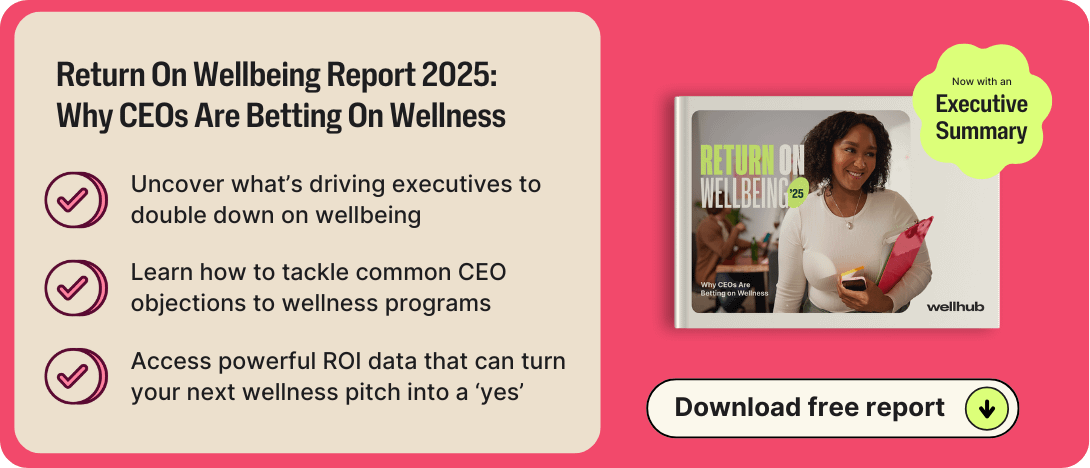
What You'll Learn
- Why U.S. HR leaders rank employee wellness as a top business priority in 2025, backed by data on cost savings, retention, and productivity gains.
- How whole-person wellness programs that address physical, mental, emotional, financial, and social needs outperform single-focus initiatives in ROI and engagement.
- The 10 core components of leading wellness programs, with 27 example initiatives companies use to boost health, morale, and inclusion.
- How to measure both ROI and VOI to prove wellness program impact on healthcare costs, turnover, culture, and performance.
- Real-world Wellhub results showing measurable savings, higher retention, and improved employee health across industries and company sizes.
Dive deep into how workplace wellness can make your organization more successful.
U.S. Statistics That Prove Wellness is a Strategic Priority for HR in 2025
Wellness has evolved from a small add-on benefit into a critical pillar of business success. Several converging trends are driving HR leaders to prioritize employee wellbeing:
- Skyrocketing Healthcare Costs: Insurance and medical expenses are climbing fast, eating into profits. Preventive wellness programs help turn the tide—91% of HR leaders say these programs have lowered healthcare costs. By helping employees tackle health issues early, companies avoid high-cost claims and save big on premiums.
- Turnover and Talent Wars: Turnover is expensive—up to twice an employee’s salary. Wellness programs make a difference: 98% of HR leaders say theirs reduced turnover, and 83% say wellness benefits are key to attracting talent. Gen Z, in particular, values supportive workplaces—43% report work has hurt their mental health, so they gravitate toward employers who truly invest in well-being.
- Productivity and Performance: Stressed, unhealthy employees cost companies millions in lost productivity. But when well-being improves, so does output—97% of CEOs report a productivity boost, with nearly half calling it “major.” Even small efforts, like stretch breaks, can spark more energy, focus, and engagement.
- Employee Expectations & Moral Imperative: Employees today expect their company to care about more than just their work output – they want to feel cared for as human beings. Yet only one in five employees feel that’s true. Closing this “care gap” boosts morale, loyalty, and trust. Over 90% of U.S. employers now offer mental health benefits, plus extras like mental health days, fertility support, and financial coaching—because it’s the right thing to do and it works. Employees with strong wellness support are nearly twice as likely to be happy at work.
In short, investing in wellness pays off on multiple fronts – cost containment, retention, productivity, and employer brand. It’s no wonder one in four CHROs at large companies now ranks employee wellbeing among their very top priorities.
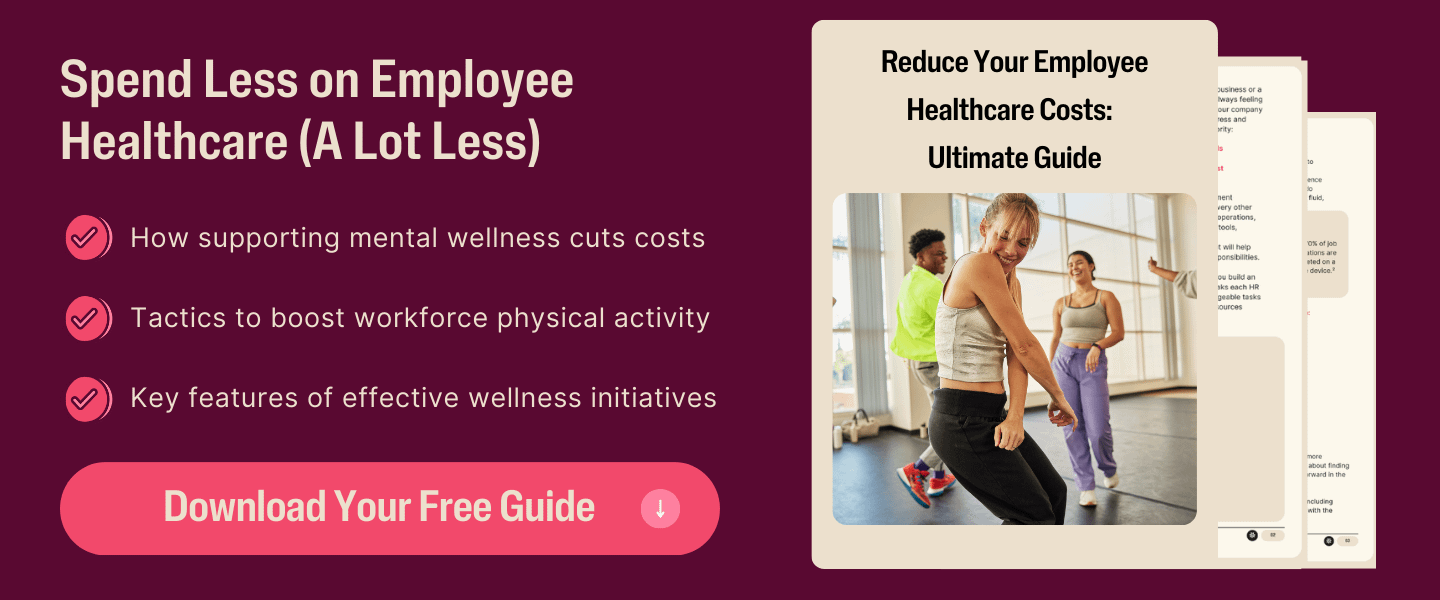
Why the Best Wellness Programs Support Whole Person Wellbeing
Old-school wellness programs stuck to one lane—like gym discounts or step challenges. Today’s best programs go all-in on the whole person—physical, mental, emotional, financial, social, and even a sense of purpose—because these areas are deeply connected.
Think about it: financial stress can fuel anxiety and poor sleep, which hurt physical health and focus. Job stress can spill into home life, straining relationships. A single perk won’t cut it. The strongest programs meet employees where they are, supporting all five of Gallup’s well-being pillars—career, social, physical, financial, and community. Yet only 6–15% of employees say their employer supports any one of those areas. That’s a big gap—and a big opportunity.
Holistic wellness delivers bigger returns. Wellhub’s recent research shows that companies offering four or more wellness options (like fitness, nutrition, mental health, and financial support) were far more likely to see strong ROI—24% hit 150%+ returns—versus under 50% ROI for one- or two-offering programs. Variety and inclusivity pay off because they tackle the root causes of burnout and disengagement, not just symptoms.
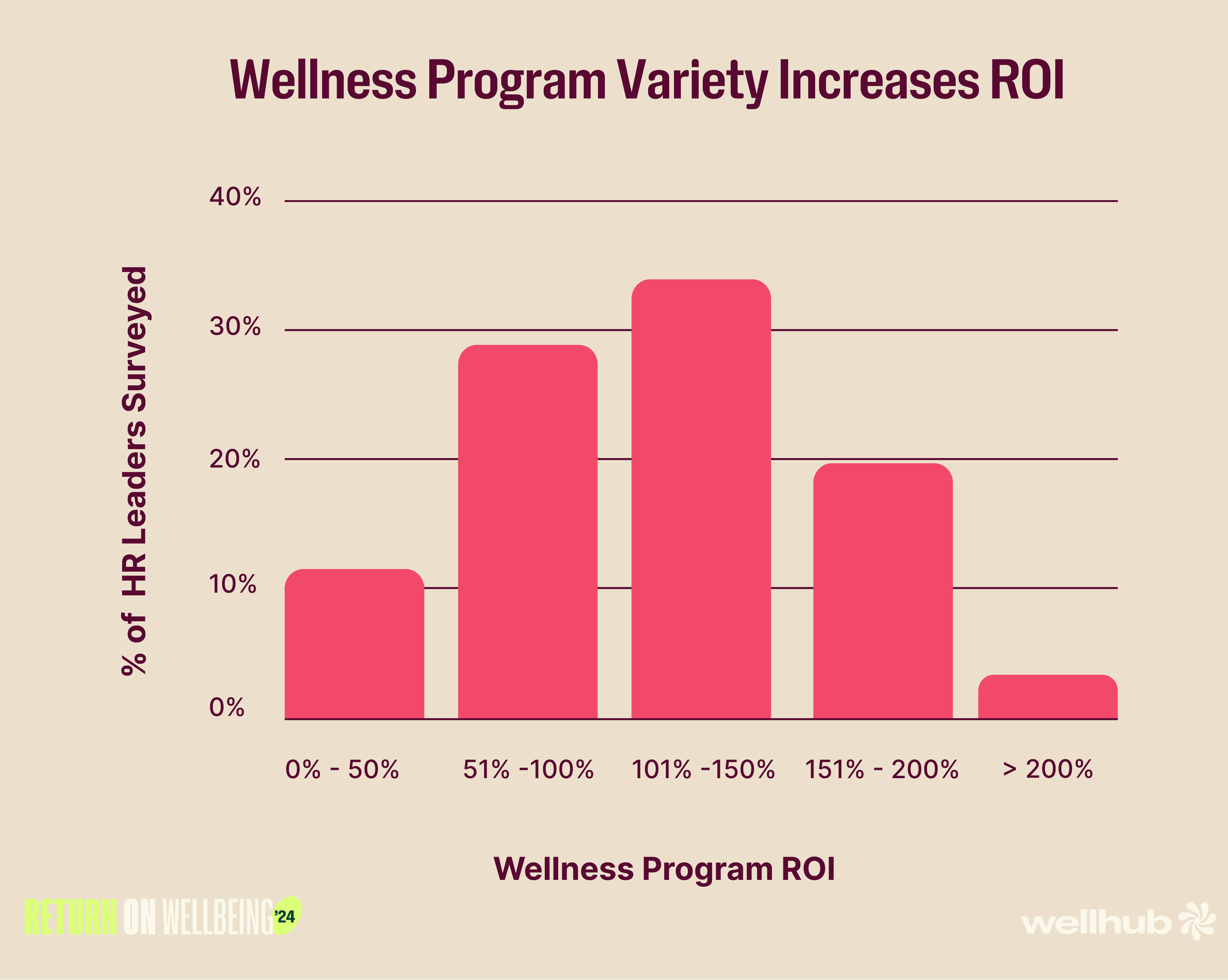
It works for every company size and industry. McKinsey’s research finds well-being challenges are universal, from manufacturing to tech. Small businesses can offer flexible schedules, a supportive culture, and budget-friendly perks. Large companies can scale personalized wellness journeys through platforms like Wellhub. The magic is in matching programs to your people and culture.
It also boosts inclusion and leadership engagement. Diverse, culturally relevant programs invite everyone to participate. And when leaders lead by example—CEOs using the wellness app, managers openly taking mental health days—participation jumps from 44% to 80%.
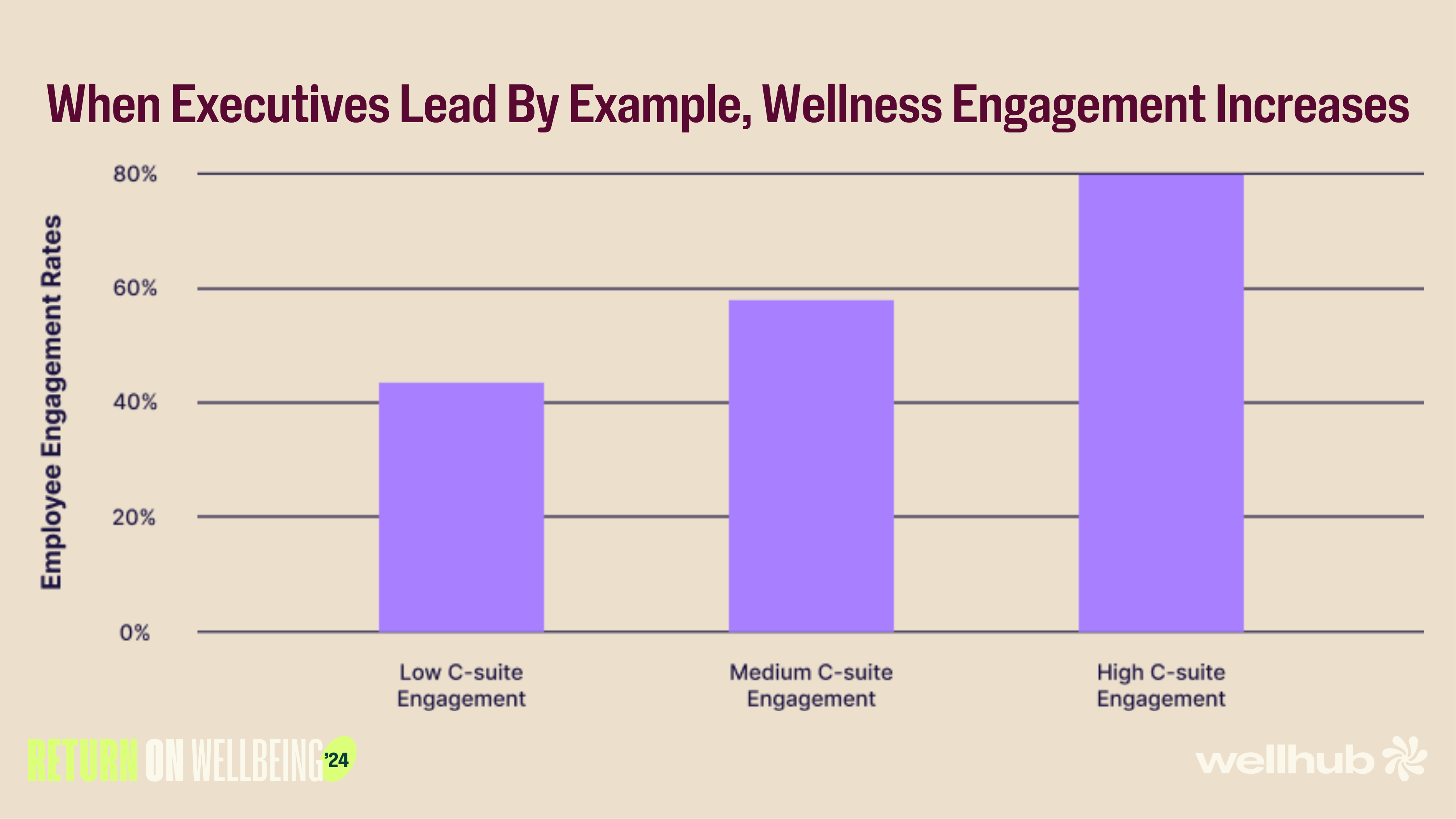
Bottom line: Whole-person wellness creates a win-win loop—healthier, happier employees perform better and stick around, fueling business success, which in turn fuels more investment in well-being.
Here’s how to find a whole-person wellness program that boosts performance.
4 Key Components of the Best Workplace Wellness Programs
A world-class wellness program typically includes multiple coordinated initiatives that target different aspects of well-being. Below, we break down examples of effective program elements across four core dimensions: Physical health, Mental & Emotional health, Financial wellness, and Social well-being. You can mix and match these ideas to craft a program tailored to your workforce. (Remember, the most successful programs offer a variety of support – a bit of something for everyone.)
Here are 27 specific wellness initiatives used by leading organizations, organized by category:
Physical Wellness Initiatives
Supporting employees’ physical health and healthy habits.
- Subsidized Gym Memberships or Fitness Apps: Cover all or part of the cost for employees to access fitness – especially flexible, all-access programs. This lowers barriers to exercise and encourages regular physical activity. For instance, offering a platform like Wellhub (which provides access to thousands of gyms and classes) gives employees convenient options to get active. Employees who exercise more frequently tend to report higher energy and productivity levels.
- Onsite and Virtual Fitness Classes: Host group workouts like yoga, Zumba, or stretching sessions either in the office or via Zoom. Scheduled “wellness breaks” for a 30-minute yoga class can help desk-bound workers reset and reduce stress. Virtual classes ensure remote and hybrid employees can join too. These activities build camaraderie while improving fitness. (Bonus: Leaders attending these classes sets a great example!)
- Step Challenges and Walking Meetings: Organize friendly step-count competitions with team goals, leaderboards, and fun prizes to get people moving. Encourage “walking meetings” or walking one-on-ones instead of conference-room chats. This weaves activity naturally into the workday.

- Ergonomic Workstations and Movement Breaks: Provide ergonomic assessments and stipends for proper chairs, standing desks, or monitor setups to reduce physical strain. Train managers to include quick stretch or “deskercise” breaks during long meetings or shifts – even 5 minutes of stretching can boost circulation and focus. Some companies invite massage therapists for periodic 10-minute chair massages as a wellness treat, easing muscle tension on the spot.
- Onsite Health Screenings & Preventive Care: Bring wellness services to employees. Examples include on-site flu shot clinics, biometric screenings (blood pressure, cholesterol checks), or mobile clinics for health risk assessments. Making preventive care convenient pays off in early detection and prevention. Ninety-one percent of HR leaders report healthcare costs decrease when employees engage in preventive wellness programs. Catching issues early can save lives and money.
- Healthy Nutrition Options: Physical wellness isn’t just exercise – nutrition is key. Stock break rooms and cafeterias with healthy snacks (fruits, nuts, yogurt) instead of just chips and soda. Install hydration stations with filtered water and perhaps fruit-infused water to encourage hydration. Some employers host healthy cooking demos or partner with a nutritionist to offer diet coaching. Given that only 40% of employees say they eat nutritiously, often due to time and cost barriers, providing nutritious options at work and education on meal prep can make a big difference.
- Rest and Recovery Support: Good sleep and rest are often overlooked in physical wellness. Top programs might offer nap pods or quiet “recharge rooms” in the office where employees can take a brief respite. Others implement policies like meeting-free lunch hours or encourage using PTO for genuine rest. Some companies even offer sleep challenge programs (tracking sleep and rewarding improvements) or provide free subscriptions to apps that encourage healthy sleep habits. Rested employees are less prone to injury and far more alert on the job
Get employees moving:
- 30 workplace wellness activities
- 17 plug-and-play physical wellness ideas
- 5 actionable employee fitness challenge ideas
- The Ultimate Guide to Workplace Wellness Challenges for HR Leaders
Mental and Emotional Wellness Initiatives
Protecting mental health, reducing stress, and building resilience.
- Employee Assistance Programs (EAP) Promotion: If you have an EAP, make sure employees actually know about it and how to use it. Too often, EAPs are underutilized – 31% of employees don’t even know if they have an EAP and 81% of those who do have one have never used it. Actively promote your EAP’s counseling, therapy, and support services. HR can send periodic reminders about EAP resources, share success stories, and perhaps offer orientation sessions on what the EAP covers (mental health, legal aid, caregiving resources, etc.). This reduces stigma and lets people know help is available before crises hit.
- Teletherapy and Coaching Benefits: Extend mental health coverage by offering virtual therapy sessions or text-based coaching through wellness apps. Many insurers or wellness vendors (including Wellhub’s partner network) provide access to licensed counselors via phone or video chat, often with a certain number of free sessions per year. Removing the barriers of cost and time (no need to travel) makes it far likelier employees will seek help when needed. Some employers also train “mental health first aid” responders on staff – employees trained to recognize signs of distress and guide coworkers to professional help.
- Mental Health Days and Flexibility: Encourage employees to take periodic mental health days – a day off to recharge when stress builds up. More companies are adding extra paid days off specifically designated for well-being. Equally important is everyday flexibility: allow mental wellness breaks during work (a short walk, a meditation break) without guilt. Flexible scheduling or remote days can alleviate stress for those juggling heavy personal demands. When managers openly take mental health days themselves and encourage their teams to unplug when needed, it normalizes self-care. This proactive approach helps prevent burnout before it starts.
Strengthen workplace mental health:
- 7 proven strategies to strengthen emotional wellness at work
- Build psychological safety with these data-backed strategies
- Mindfulness and Meditation Programs: Introduce mindfulness into the work routine. This could be via guided meditation sessions offered daily (even a 10-minute guided meditation during lunchtime), or providing app subscriptions to popular meditation apps like Headspace or Calm. Mindfulness training has been shown to reduce stress and improve focus. For example, one company had employees spend just 5–10 minutes each morning on a mindfulness exercise and saw measurable decreases in reported stress levels over a few months. A calm mind is a productive mind.
- Manager Training in Emotional Wellness: Equip leaders to support mental health. Provide training for managers on topics like recognizing signs of burnout or depression, practicing empathy and active listening, and responding when an employee is struggling. When managers have skills to discuss workload stress or personal challenges with openness, employees feel safer speaking up. Creating a culture of psychological safety – where it’s OK to say “I’m feeling overwhelmed” – goes a long way. Some organizations also appoint executive champions for mental health who regularly communicate its importance.
- Stress-Reduction Initiatives: High stress is one of the top causes of absenteeism and turnover. Beyond offering yoga or meditation, leading employers tackle stress at the culture level. This can include reasonable workload expectations (avoiding unnecessary late nights), encouraging people to truly unplug on vacations, and fostering a supportive team atmosphere. Specific ideas: “No Meeting Fridays” to give focus time, quiet rooms in offices where people can decompress, or hosting stress-management workshops with practical tips. Even fun team activities like laughter yoga or art therapy sessions can relieve tension and remind employees it’s okay to relax and have fun at work.
- Culture of Connection and Openness: Ensure that mental wellness isn’t just a private matter but built into team norms. Managers might start meetings by doing a quick check-in (“How’s everyone holding up this week?”). Companies are also creating peer support groups or circles where employees can share and discuss challenges – for example, a working parents support group, or a weekly mindfulness circle. Reducing stigma is critical: nearly eight in 10 workers say they’ve experienced mental health stigma at work in the past, which can prevent them from seeking help. By openly talking about mental health, celebrating those who utilize resources, and incorporating well-being into day-to-day conversations, you create a safe, inclusive environment.
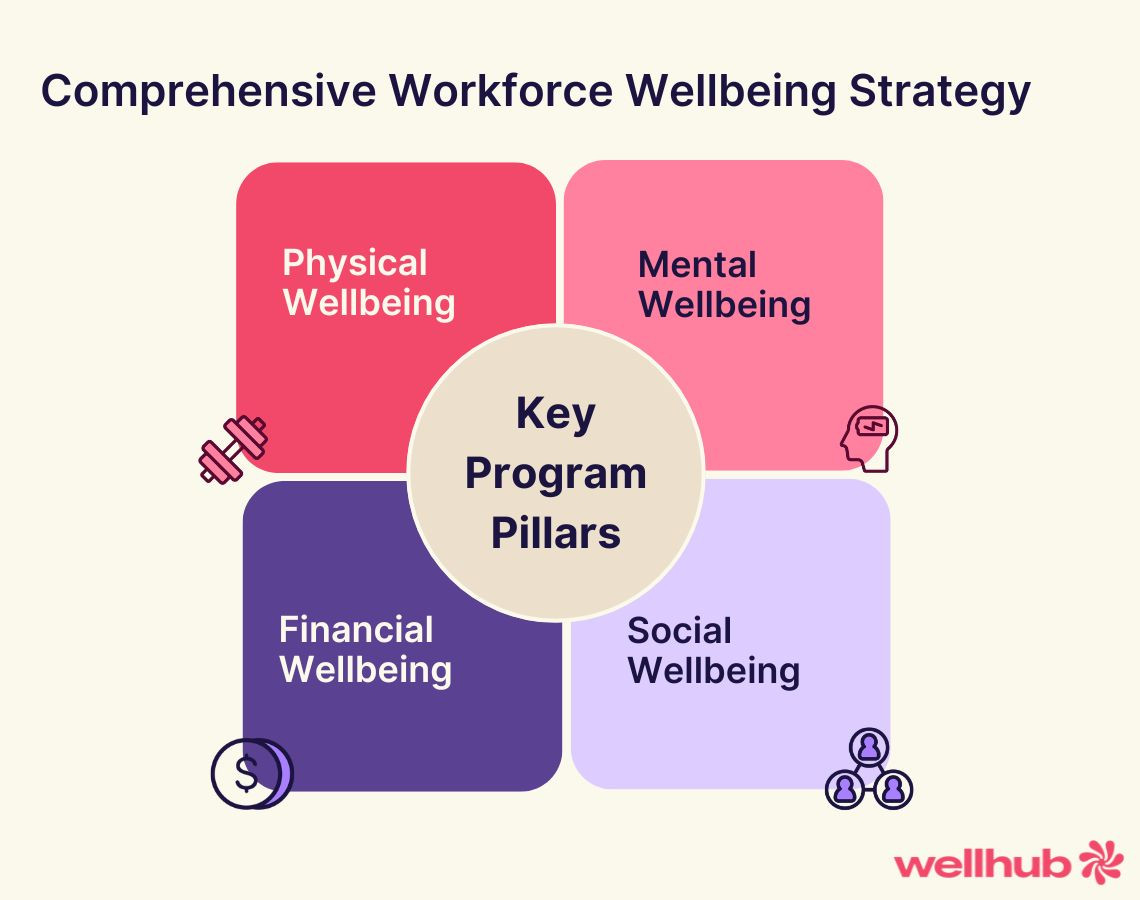
Financial Wellness Initiatives
Helping employees reduce financial stress and build stability.
- Financial Education Workshops: Money worries are a major stressor for many employees – 68% say their financial situation holds them back from improving overall wellbeing. Offering financial literacy programs can empower your team. Host workshops or lunch-and-learns on budgeting, debt management, and saving. Bring in financial planners or use online courses to teach topics like retirement planning, student loan repayment strategies, or home-buying 101. Some employers partner with financial wellness platforms or credit unions to provide ongoing education and personalized coaching. When people feel more in control of their money, their stress levels drop.
- One-on-One Financial Coaching or Counseling: In addition to group education, providing access to individual financial counseling can be transformative. Many EAPs or specialized vendors offer confidential money coaching sessions. Employees can get help with creating a budget, tackling credit issues, or planning for big expenses. This personalized guidance helps employees take concrete steps toward their financial goals (like building an emergency fund). It’s an investment in peace of mind – workers who feel financially secure are more focused at work.
- Student Loan Assistance or Repayment Programs: One increasingly popular benefit is helping employees with student debt. Employers might contribute a certain amount each month toward employees’ loans or offer refinancing assistance. Even a $50–$100 monthly contribution can meaningfully chip away at balances and demonstrates you care about employees’ futures. Some companies structure it as a matching program (similar to 401k matches) for extra incentive. Given the heavy burden of student loans on younger employees, this benefit can significantly relieve financial stress and improve loyalty.
- Emergency Savings Programs: Another valuable initiative is enabling employees to build emergency savings. For example, automatically diverting a small portion of each paycheck (with opt-out available) into a savings account or offering bonuses for completing financial wellness milestones (like saving $500). A few employers have started providing company “safety nets” – small emergency loans or grants for employees facing sudden hardships. Knowing that support is there in a pinch can greatly reduce anxiety about unexpected expenses.
- Maximize Employee Benefits Education: Often, employees don’t fully understand or utilize the financial benefits already available to them (401(k) match, HSA/FSA accounts, discount programs, etc.). Regularly educate staff on how to leverage these. Host “benefits Q&A” sessions or send out seasonal reminders (e.g. “Use your FSA dollars before year-end”). Ensure retirement plan vendors are available for consultations. When employees take advantage of matching retirement contributions or tax-free savings accounts, they’re essentially getting free money – yet many leave that on the table due to lack of knowledge. Close that awareness gap to improve their long-term financial wellness.
- Insurance and Protection Benefits: Financial wellness also means having the right protections. Top programs include guidance on choosing appropriate health insurance plans, life and disability insurance, and even things like identity theft protection or legal services. By helping employees get insured and prepared, you buffer them (and the company) from financial catastrophes. For instance, an employee without disability insurance who gets injured might face bankruptcy – which can ripple into the workplace. Proactively educating and enrolling folks in these benefits is a preventative wellness step.
- Recognition and Fair Pay: While not a “program” per se, an often-overlooked aspect of financial well-being is simply making sure employees feel fairly compensated and recognized. Regularly analyze pay equity and adjust if needed. Consider spot bonuses or financial rewards for achievements. Non-monetary recognition (public kudos, extra time off) also contributes to an overall sense of appreciation, which can alleviate the mental strain of financial worries. An employee who feels valued may be better able to handle financial stress outside work. In essence, a culture that pays and praises fairly is part of financial wellness.
Keep top talent inspired with this professional growth blueprint. [20 ideas]
Social and Community Wellness Initiatives
Fostering connection, community, and a sense of belonging at work.
- Employee Volunteer Days: Altruism and community service can hugely boost morale and team spirit. Organize volunteer opportunities and give employees paid time to volunteer together. This might mean team volunteer days at local charities – cleaning up a park, working at a food bank, mentoring youth, etc. Not only does this build teamwork and a sense of purpose, but it also connects employees to the broader community. Many companies find that their volunteer programs increase employees’ pride in the organization. As a bonus, giving back is great for mental wellbeing – it’s hard to feel isolated when you’re bonding with colleagues over doing good.
- Social Clubs and Interest Groups: Support the formation of employee-led social clubs around common interests. For example, companies have had success with clubs for book reading, running, cooking, gaming, gardening – even fantasy football leagues. Provide a small budget or resources for these groups to meet (virtually or in-person) and maybe showcase their activities in company newsletters. These social outlets help people form friendships beyond their immediate work team, which increases their sense of belonging. Especially in hybrid/remote workplaces, intentional social groups keep people connected on a human level.
- Team-Building Events (Fun and Low-Pressure): Plan regular all-team or department-level events that are simply about having fun and bonding – not work. Think trivia nights, escape room challenges, team potlucks, or creative contests. The key is to make them inclusive and low-pressure (no forced trust falls!). By giving employees occasions to relax together, you strengthen relationships and communication. Social well-being at work often comes down to whether people feel they have friends and enjoy being part of the team. Frequent lighthearted events go a long way in that regard.
- Mentorship and Buddy Programs: Launch a mentorship program pairing employees across different levels or departments. For new hires, also consider a “buddy” system to help them integrate socially. Mentorship builds personal connections and knowledge sharing, and it signals that the company cares about personal growth. A cross-department mentor/mentee might meet biweekly to chat not just about career goals but also to check in on how the employee is feeling about work. These relationships can mitigate feelings of isolation and provide a support network within the company.
- Celebrating Milestones and Personal Wins: Create a culture that recognizes employees as people with lives outside work. Celebrate birthdays, work anniversaries, new babies, graduations – any milestone big or small. Shout-outs in company meetings or intranet, a card signed by the team, or a small gift card can make someone feel seen and appreciated. Publicly acknowledging personal and professional milestones fosters a family-like atmosphere. When people feel cared about personally, their social wellness at work improves. It’s a simple way to reinforce that “we’re all in this together.”
- Inclusive Employee Resource Groups (ERGs): Support ERGs or affinity groups that allow employees who share backgrounds or interests to connect (e.g. a Women in Leadership group, LGBTQ+ group, Young Professionals group). These communities provide social support and a platform for voices that might otherwise feel underrepresented. Give ERGs a budget and leadership support to host events or forums. Employees active in ERGs often report higher engagement and loyalty because they have a strong community at work. Inclusion is a form of wellness – when people can bring their whole selves to work and find community, their overall satisfaction soars.
The common thread across these initiatives is creating a workplace where employees feel supported in all facets of life. By implementing a diverse set of programs, you address the varied needs of your workforce – from the fitness enthusiast training for a marathon, to the new parent coping with sleep deprivation, to the young grad worried about student loans.
And remember, you don’t have to roll out all 27 ideas at once! The most effective programs often start small and phase in initiatives over time, guided by employee feedback and participation data.
How an Effective Workplace Wellness Program Boosts Your Bottom Line
When wellbeing becomes part of your strategy, performance improves and costs go down. Talk about a win-win!
Here’s how HR leaders across industries are using wellness programs to drive results.
Launch a wellness program that lifts engagement and lowers costs.
Boosting Employee Engagement and Retention
When employees feel supported, they stay. It’s that simple. A wellness program signals that your organization values the whole person — not just their output. And that matters.
Here’s how wellness boosts engagement and retention:
- Reduced turnover costs: Turnover is expensive. Replacing an employee can cost up to 200% of their annual salary. Investing in wellness helps you hold onto top talent: 98% of HR leaders say their wellbeing program reduces turnover.
- Higher job satisfaction and loyalty: Employees who feel cared for are 3X more likely to stay with their employer, according to Wellhub’s State of Work-Life Wellness 2024 report.
- Talent attraction: In a talent market where 89% of employees will only consider companies that place a clear emphasis on employee wellbeing in their next job hunt, wellness programs can differentiate your employer brand.
This is about more than perks. It’s about creating a workplace people don’t want to leave.
Reduced Healthcare Costs, Less Absenteeism
Thoughtfully designed wellness programs can drive down insurance claims and promote consistent attendance.
What that looks like in action:
- Lower insurance claims: Organizations with wellness programs are three times more likely to report lower healthcare costs.
- Savings are growing: Ninety-one percent of companies in 2024 reported healthcare costs decrease because of their wellbeing program, up from 78% in 2023.
- Fewer sick days: Nearly 11 times more likely, actually. That’s how much more likely employers with wellness initiatives are to see reductions in absenteeism. And leaders are taking note: 67% of CEOs say their wellness program significantly reduces employee absenteeism.
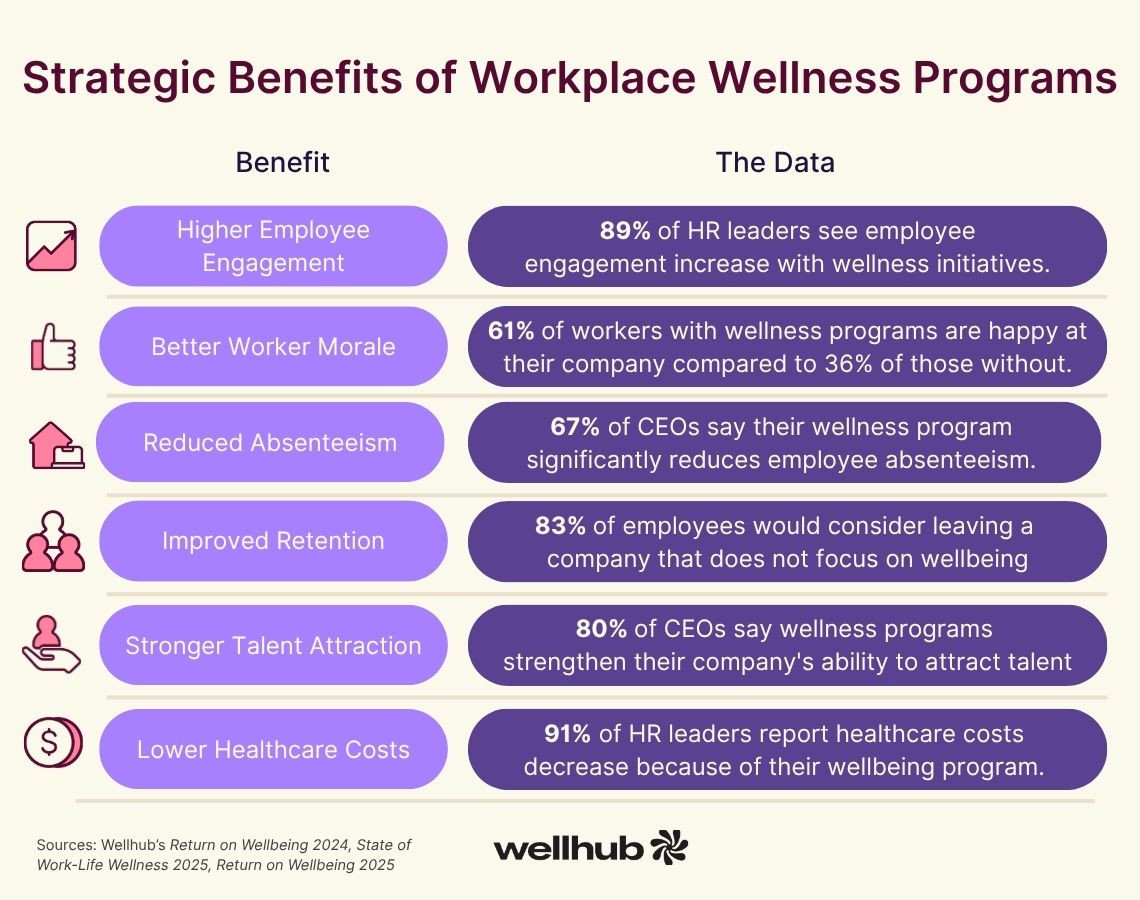
More Productivity and Resilience
Happy, healthy employees aren’t just less expensive — they’re more effective. Wellness programs can supercharge team output by creating an environment that fosters sustainable performance.
Key performance gains include:
- Greater productivity: This is nearly universal, with 97% of CEOs saying their wellness programs improve productivity at least slightly. And these aren’t marginal gains: As revealed in Wellhub’s Return on Wellbeing 2025 report, nearly half call the boost “significant.”
- Improved focus and energy levels: Companies that provide wellness tools like fitness programs, sleep tracking, and nutrition support report 36% increase in productivity and improved focus/energy among participants.
- Greater resilience: Wellbeing programs effectively carry employees through trying times: Nearly three out of four CEOs say their wellness initiatives are very or extremely impactful in fostering resilience in employees.
- Better problem-solving and creativity: Even brief meditation sessions can boost creativity, which matters when you’re trying to stay ahead of the competition.
Wellness is a powerful performance multiplier.
Cultivating a Resilient and Positive Company Culture
Culture is what people feel when they walk into (or log onto) work. A strong wellness program creates a sense of safety, community, and shared purpose.
Here’s how wellness supports a thriving culture:
- Stronger team cohesion: Wellness challenges, team yoga, and gratitude initiatives foster camaraderie and connection — 72% of organizations with wellness programs report improved teamwork.
- Improved morale and psychological safety: More than nine in 10 workers say they’re more motivated when leaders support well-being efforts, and employee morale is cited as the most improved metric after wellness program implementation (54%).
When it comes to culture, what you fund speaks louder than what you say.
🦆 Aflac case study: From Medications to Movement: How Aflac Sparked A Culture Shift with Wellhub
Measuring Success: Wellness Program ROI, VOI, and KPIs
ROI vs VOI
After launching wellness initiatives, HR leaders must prove they are making a difference. This is where ROI (Return on Investment) and VOI (Value on Investment) come into play. Both are crucial metrics, but they capture different aspects of success:
- ROI (Return on Investment): This is the direct financial return of your wellness program. ROI asks: Do the savings and gains outweigh the costs? It’s typically calculated by comparing program costs to measurable outcomes like healthcare savings or reduced turnover expenses.
For example, if your wellness program cost $100,000 and you saved $150,000 in reduced medical claims and sick pay, that’s a 1.5:1 ROI (or 150% return). Many companies are indeed seeing strong ROI: 95% of employers who track wellness ROI report positive returns. Over half report getting more than $2 back for every $1 spent after factoring in healthcare savings and productivity gains. Hard ROI metrics to monitor include changes in total healthcare spend year-over-year, number of sick days taken (absenteeism costs), workers’ comp or disability claims, and turnover rates (replacing employees is expensive, so lowered turnover saves money). One analysis by RAND Corp found an average ROI of $1.50 for every $1 invested in wellness, with even higher returns (up to $3.80:1) for targeted disease management programs. The takeaway: done right, wellness programs can pay for themselves (and then some) through hard savings.
- VOI (Value on Investment): VOI captures the broader, intangible benefits of wellness programs – things like improved employee morale, engagement, innovation, and company reputation.
This matters because not everything that matters shows up on a financial ledger. VOI captures “softer” outcomes that are critically important and lead to long-term success. For instance, if your wellness initiative dramatically improves team morale, you might see higher customer satisfaction or better quality work, even if you can’t directly attribute a dollar value. Improved engagement, resilience, and employer brand are common VOI benefits from wellness efforts. How do you measure VOI? Through surveys and trends: look at changes in employee engagement survey scores, self-reported stress levels, job satisfaction ratings, or eNPS (employee Net Promoter Score). Track whether departments with high wellness participation also see boosts in performance or creativity. Importantly, more organizations are recognizing these holistic returns – fully 62% of companies now prioritize employee well-being and sense of purpose over mere cost-cutting. In other words, the culture and human impact are being valued alongside the financials. VOI is about the story behind the numbers – the healthier, happier workforce that drives success in ways that unfold over years.
A strong wellness program measures both ROI and VOI. ROI builds your business case in concrete terms (to satisfy the CFO), while VOI captures the true breadth of positive changes (to satisfy the CEO and HR’s mission). When presenting results, paint a full picture: e.g., “Healthcare costs decreased 5% this year saving $200K (ROI), and our employee engagement scores rose 10 points and voluntary turnover dropped 3 percentage points (VOI).” Together, these metrics demonstrate that wellness isn’t just an expense line – it’s an investment yielding financial returns and a more vibrant workforce.
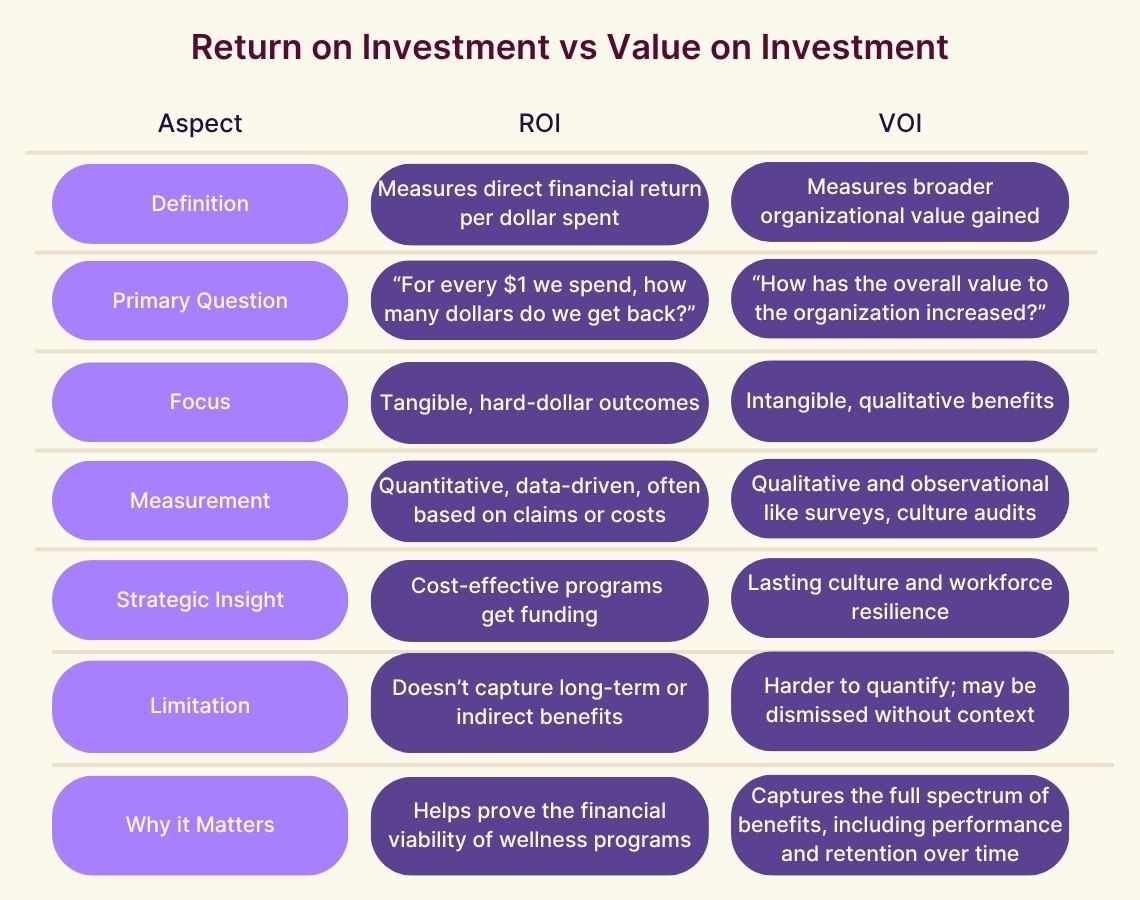
Key Wellness KPIs
Key Metrics to Track
- Participation rates: Percentage of employees using the program
- Health indicators: Aggregate improvements in weight, blood pressure, etc.
- Absenteeism and presenteeism rates: Trends in sick days and on-the-job productivity
- Employee retention: Changes in turnover rates
- Employee feedback: Wellbeing scores and sentiment in surveys
Examples of Wellness Program Wins
- Productivity & cost savings: Sick days drop 20% after introducing wellness days or on-site flu shots
- Loyalty boost: Engagement survey shows sharp increase in “I would recommend my company as a great place to work.”
Here’s how to find a whole-person wellness program that boosts performance.
Best Practices for Measurement
- Start with baseline data: Measure key metrics before launching initiatives to track true changes
- Continuous improvement: Review data regularly and refine programs
- Double down on what works: Keep high-attendance programs like popular virtual fitness classes
- Rework low-engagement areas: Adjust topics or format for underperforming programs (e.g., financial webinars)
Employee Input
- Ask regularly: What do employees value most?
- Identify barriers: Understand what keeps them from participating
- Iterate: Use insights to evolve your wellness strategy for stronger ROI and VOI over time
Real-World Wellbeing Program Success in 2025: Welcome to Wellhub Effect
Wellhub does more than support your team. It supports your strategy.
Across industries, employee demographics, and geographies, Wellhub consistently improves employee health, reduces organizational costs, and strengthens workforce retention.
Here’s what that impact looks like in action.
A Proven ROI for Businesses of Every Size
Let’s start with the numbers. On average, companies that invest in Wellhub see greater than 3 times return — and that’s not a theoretical model. It’s based on real-world data from Wellhub’s extensive global client base.
In 2023 alone, Wellhub delivered over $540 million in value to clients and users:
- $200 million in reduced healthcare costs
- $50 million in saved recruiting costs due to improved retention
- $290 million in annual gym membership savings for employees
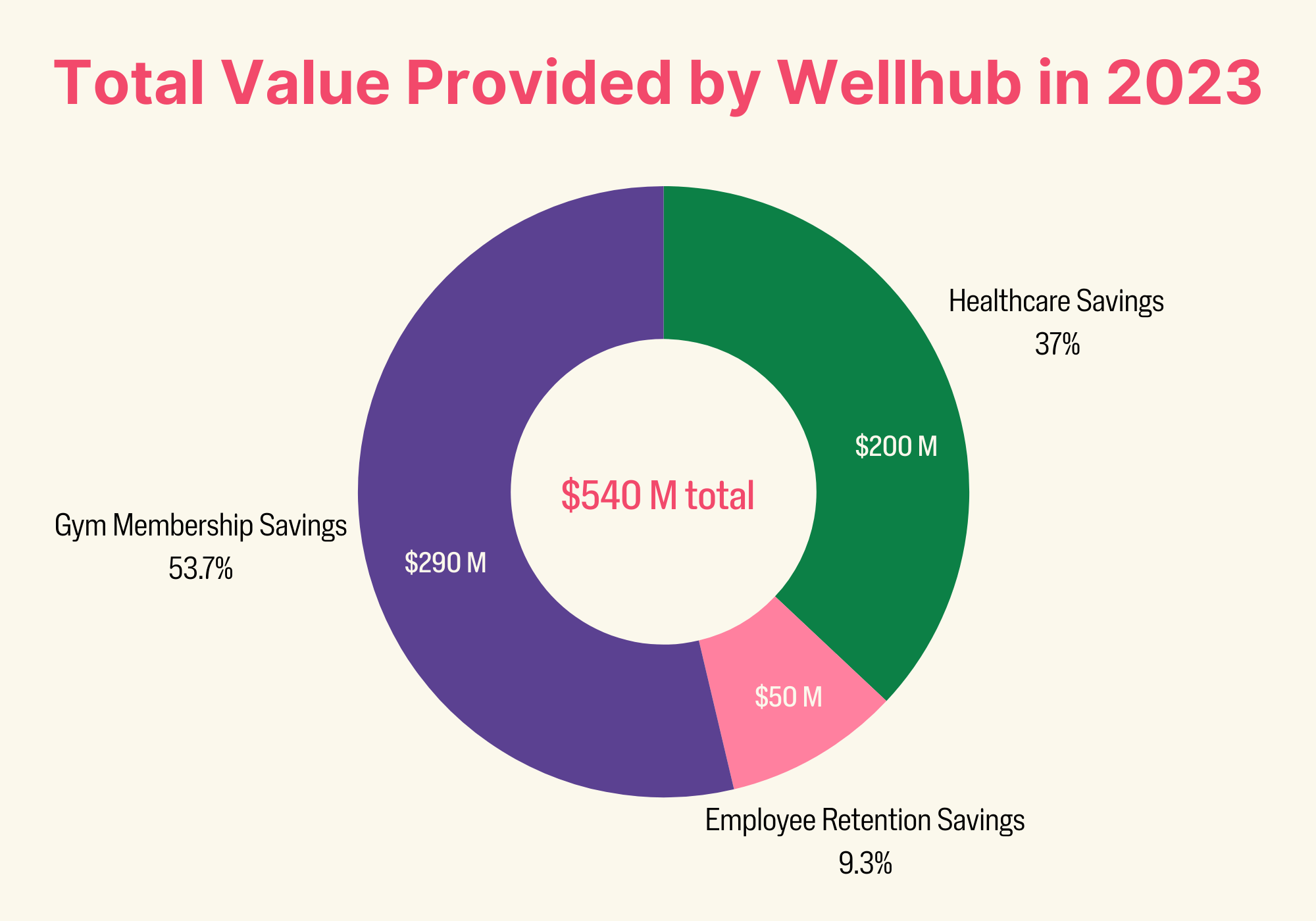
Healthier Employees, Lower Healthcare Costs
Wellhub doesn’t just encourage healthy habits — it changes health outcomes. Employees who check in five or more times per month see their healthcare costs drop by 21% within a year, while non-users saw their costs rise by 14% over the same period. That’s a 35% swing in cost savings driven by consistent wellness engagement.
This isn’t just theory — it’s backed by a longitudinal study spanning three years and more than 50,000 participants across multiple industries and company sizes.
Retention That Moves the Needle
Companies using Wellhub also retain more talent. In a year-long analysis, 88% of companies reported lower turnover rates among employees actively using Wellhub. Those who checked in at least once a month were 30% less likely to leave their employer compared to those who didn’t use the program at all.
When you consider that replacing a single employee can cost up to one month’s salary, the savings add up quickly — and the cultural impact is even bigger.
Employee Savings That Matter
Wellhub helps your people make wellness more affordable. U.S. employees using Wellhub save an average of$924 annually on fitness memberships, apps, and studio visits — a 50% reduction in what they would pay without the benefit.
For HR leaders trying to make every benefit dollar count, that’s a powerful indirect compensation strategy. Who doesn’t love a benefits package change that makes you competitive and your team happier?
The Daily Wellhub Difference
How often employees use Wellhub directly correlates with howpositively they view their benefits and rate their wellbeing:
- 93% of daily users rate their benefits package positively, compared to 64% of monthly users
- 71% of daily users report strong mental wellness, compared to 53% of those without Wellhub
- 55% of daily users say they get quality sleep, compared to 26% without the program
The more they use it, the better they feel — and the more they bring to work every day.
If you’re a CHRO trying to prove your department’s impact on the bottom line, Wellhub gives you the data to do it. It ties employee wellness to productivity, retention, engagement, and real dollar savings. And it does all this in a way that meets the expectations of today’s workforce — who overwhelmingly say they’ll only work for companies that prioritize wellbeing.
We made it easy: Launch your wellness program with this step-by-step guide.
Wellbeing Is the Strategic Advantage HR Can't Afford to Overlook
Rising healthcare costs, high turnover, and growing employee demands are pushing HR to rethink benefits. Supporting wellbeing isn’t optional anymore — it’s essential.
Offering a best-in-class wellbeing program directly tackles these challenges. It lowers healthcare spending, boosts retention, and drives productivity. Companies offering holistic support are 90% more likely to see positive ROI, and 91% of HR leaders say their programs cut healthcare costs.
Speak with a Wellhub Wellbeing Specialist to lower costs, retain top talent, and build a culture where your people thrive!

Company healthcare costs drop by up to 35% with Wellhub*
See how we can help you reduce your healthcare spending.
Category
Share

The Wellhub Editorial Team empowers HR leaders to support worker wellbeing. Our original research, trend analyses, and helpful how-tos provide the tools they need to improve workforce wellness in today's fast-shifting professional landscape.
Subscribe
Our weekly newsletter is your source of education and inspiration to help you create a corporate wellness program that actually matters.
Subscribe
Our weekly newsletter is your source of education and inspiration to help you create a corporate wellness program that actually matters.
You May Also Like

Corporate Wellness Trends HR Must Know for 2026 | Wellhub
See the top 2026 wellness trends shaping performance, retention, and culture—plus how HR can build a unified, ROI-driven wellbeing strategy.

Wellness Points Programs: Boost Employee Health & Engagement | Wellhub
Turn your workplace wellness strategy around with a points program that rewards healthy behavior with perks, from extra time off to gift cards.

Employee Financial Wellness Programs: Ultimate HR Guide | Wellhub
Create an effective financial wellness program that supports your employees in their financial needs, boosting productivity and retention.